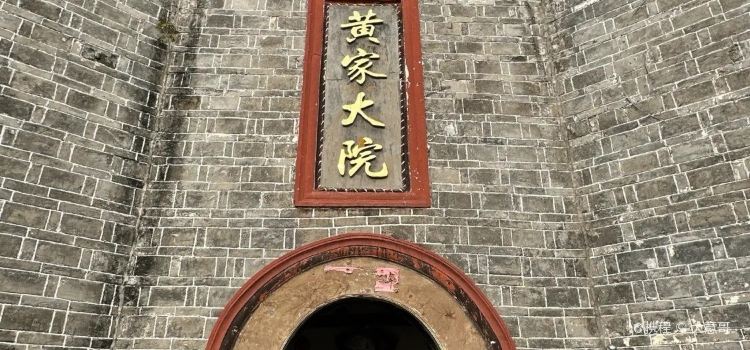HUANG GU DA YUAN
4/56 Reviews
€5

Currently closed|Open at 10:30 today
0816-3731966
What travelers say:

The food here tastes good, and you can relax after dinner.
More
Reviews of HUANG GU DA YUAN
Some reviews may have been translated by Google Translate
4/5Excellent
All (6)
Latest
Photo reviews (3)
Positive reviews (1)
The food here tastes good, and you can relax after dinner.
Qinglinkou Citywalk | I've traveled back to Sichuan in the 1930s! There are countless ancient towns in Sichuan, but Qinglinkou Ancient Town stands out. Founded in the late Yuan Dynasty and early Ming Dynasty, Qinglinkou Ancient Town is a secluded town perhaps even unknown to Sichuanese. Free of tour groups and commercialism, it offers an authentic and pristine environment. Its courtyard houses, pavilions, and stilt houses retain architectural styles from the Ming, Qing, and Republican periods. Most strikingly, the Red Army passed through this area during the Long March, leaving behind many period slogans that truly felt like they had been transported back to Sichuan in the 1930s. Qinglinkou's three specialties: preserved eggs, fermented black bean paste, and a tofu feast. Must-see attractions: Red Army Bridge: Qing Dynasty Stone arch bridge 🏯, covered in various red slogans Fire God Temple: Built during the Guangxu period Various guild halls: Jiangxi, Huguang, Fujian, Guangdong, and Shaanxi Walking route → Turn left at Changkou Archway Bridge → Fuji Family Courtyard → Old Street → Turn right → Wenchang Palace → Wanshou Palace, Shiliangzi Plank Road, Fire God Temple ⛩️ Transportation: Driving 🚗 is most convenient. Public transportation: Take the shuttle bus from Jiangyou to Erlangmiao Town 🚌 and get off at Qinglinkou Ancient Town. Tips: Yuwang Palace is the Huguang Guild Hall, and Wanshou Palace is the Jiangxi Guild Hall. Qinglinkou is located at the junction of Jiangyou, Jiange, and Zitong counties. #TheAncientTownWithTheMostTime-TravelingFeeling #Farewell2024Welcome2025 #DayTour #AncientTownsAndVillagesWorthyVisit #StudyTour
First Stop: Qinglinkou Ancient Town Qinglinkou Ancient Town is located in a small mountain valley southwest of Erlangmiao Town, approximately 40 kilometers northeast of Jiangyou City. It sits on a major transportation route between Zitong, Jiange, and Jiangyou counties, where the Tongjiang River and the Qingyun River (Qianhe River) converge. This relatively unknown ancient town maintains the tranquility expected of an ancient town. Walking along a winding path, we entered the ancient town's new street. The narrow, ancient stone paved streets are lined with old houses, each built with traditional eaves and wooden structures. These typical Ming and Qing dynasty buildings each have their own distinct characteristics, including quadrangle courtyards, three-story terraced houses, and unique suspended stilt houses. For lunch, enjoy a tofu banquet, one of Qinglinkou's "Four Wonders." For larger groups, order set meals, ranging from 100 to 200 yuan. The menu offers a wide variety of dishes, and you can choose according to the number of people. It's a great value, and the food is delicious. We ordered two tofu dishes and a cold wild vegetable salad. The kidney tofu was delicious and tender, and the wild vegetables were also very good, though I forgot their names. On the way back, I also bought some preserved eggs for 2 RMB each. I loved them so much that I asked for my contact information to ship them. Second stop: Picking persimmons in the Yaowanli Persimmon Forest 🍅 Yaowanli is a small, unassuming village in the Jiangyou mountains. Nearly 2,000 persimmon trees are grown here, representing sweet Taiwanese persimmons introduced over 20 years ago. Several other families in the nearby hills also plant persimmon trees, bringing the total to over 4,000 in Yaowan. The trees are laden with fruit, and it's now the season for crisp persimmons. Crisp persimmons are a different variety from those used to make dried persimmon cakes; they can be eaten freshly peeled and eaten. Freshly picked and sold on the mountain, crisp persimmons are 4 RMB per kilo. The persimmon trees, over 20 years old, aren't very tall, but they have their own unique shape. The bright red persimmons hang from the trees like little lanterns, perfect for portraits but not for landscape photography. You can also just take photos and not buy any persimmons. However, most people return with bags and bags full of them. Persimmons are very sweet. If you're taking them home, you can pick some that are not too hard and eat them right away, or you can pick some that are a little raw and let them sit for a while before eating. Local farmers also sell free-range eggs and fresh vegetables.
Qinglinkou Ancient Town in Jiangyou, Mianyang, Sichuan, boasts a rich history. Surrounded by mountains and lush greenery, the area is named "Qinglinkou" for the steep pass formed by Wangye Mountain and Renzi Mountain to the southeast of the town. The town boasts a nationally protected cluster of Qing Dynasty buildings, including the historic Red Army Bridge and its stone slogans, as well as attractions such as the Fujian and Guangdong Guild Hall and the Fire God Temple. It takes about an hour to reach the town by car from downtown Mianyang, and a tour of the town itself takes about an hour. Entering the town, you'll be struck by its untouched, pristine beauty. The relaxed pace of life here offers a tranquil escape from the hustle and bustle of the city, making it a perfect weekend getaway for a relaxing stroll. With a bit of luck, you might even stumble upon a few adorable farm dogs! Please note that parking is 10 yuan. The town offers a wide variety of local specialties, including fermented black bean paste (doubanjiang), soy products, steamed eggs (2 yuan each), and handmade peach slices. Flavors include salt and pepper, original, walnut, and rose, all priced at 10 yuan per box. If you're feeling hungry, try the cold jelly noodles sold by local vendors for 6 yuan per bowl. They also offer delicious grilled skewers. Come to Qinglinkou Ancient Town and experience its unique charm and tranquil beauty! #TheMostTime-TravelingAncientTown #SpringFun #WhereToGoThisWeekend #AncientTownsAndVillagesWorthyToVisit #SoloTravel